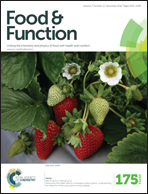Elevated propionate and butyrate in fecal ferments of hydrolysates generated by oxalic acid treatment of corn bran arabinoxylan
Abstract
Previous work in our laboratory showed that alkali-solubilized corn arabinoxylan (CAX) has a slow initial, but later complete, in vitro human fecal fermentation. CAX and a moderately high molecular weight hydrolysate (CH) were propiogenic, and produced low levels of butyrate. Here, we show that oxalic acid-generated hydrolysates from CAX, which include a large xylooligosaccharide, and free arabinose fractions, increased short chain fatty acid (SCFA) production, which included relatively high levels of both propionate and butyrate, an unusual SCFA combination. Hydrolytic degradation of CAX by acid hydrolysis (0.05 M oxalic acid at 100 °C for 2 h) and subsequent graded ethanol precipitations were used to obtain mixtures with different molecular weight ranges. Ethanol-precipitated fractions (F 0–65%, F 65–75%, F 75–85%) were mostly lower than 100 kDa and F > 85% was composed of monosaccharides and oligosaccharides of DP 2–8. Oxalic acid treatment caused the removal of all single arabinose unit branch chains and some di/trisaccharide branch chains, producing lightly substituted xylan backbone fragments, most of which were in the oligosaccharide (DP < 10) size range. In vitro human fecal fermentation analyses showed all oxalic acid–hydrolysate fractions were slower fermenting than fructooligosaccharides (FOS), but produced similar or higher amounts of total SCFAs. Butyrate production in two hydrolyzate fractions was double that of CH, while propionate levels remained relatively high.


 Please wait while we load your content...
Please wait while we load your content...